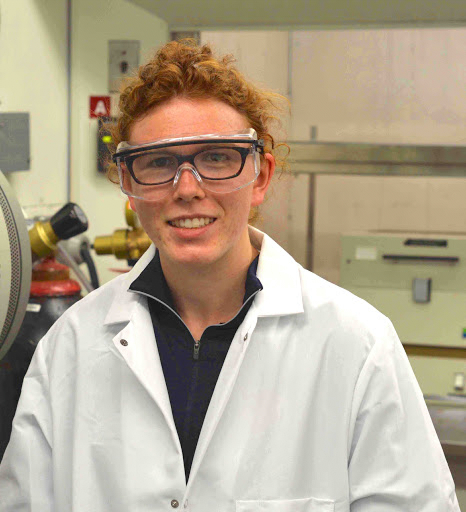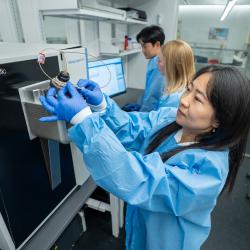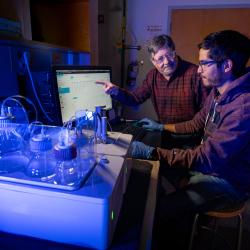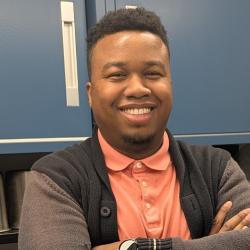Ph.D. Student Stephanie Gnewuch Studies the Beauty of Chemistry
Ruby red. Sapphire blue. Sparkling crystals.
To see something this beautiful, most people would have to go to their local jewelry store or visit a nearby museum. But Stephanie Gnewuch gets to look at beautiful crystals every day.
Gnewuch is not a museum curator or a gemologist. She’s a chemistry Ph.D. student at the University of Maryland studying crystallography.
In her research, the beauty of crystals goes far beneath the surface. Gnewuch bombards crystalline materials with neutrons to analyze how the neutrons are diffracted. Using the diffraction patterns, she can model the crystal’s structure as well as the magnetic alignment in each individual atom within the crystal.
If each atom in the crystal is thought of as a tiny magnet, and the direction of the polarity could be changed at will, the atoms could be arranged into positive and negative sequences like the binary code of ones and zeros that computers use to store information. Understanding that alignment, as well as how that alignment can be changed, may lead to new materials for storing information.
“We’re interested in learning if you can get these materials to arrange in particular ways spontaneously by cooling them down, or if you need to apply magnetic or electric fields,” Gnewuch said. “Their magneto-electric properties make them very interesting for potential memory storage devices, because you could read or write the memory using magnetic fields or electric currents.”
Gnewuch’s research on the special magnetic properties of crystals is funded by the U.S. Department of Energy’s Office of Basic Energy Sciences neutron scattering program. She conducts many of her experiments at the National Institute of Standards and Technology’s (NIST) Center for Neutron Research. She developed relationships with scientists there as an undergraduate when she participated in the center’s summer research fellowship program.
While she is glad to have guest researcher status at NIST, which allows her to use the instruments at the facilities to conduct her research, she is excited for the opportunities that the new chemistry building wing at UMD will bring for future students. Namely, enhancing the ability for students studying crystallography to conduct their research on campus.
“That’s something that we’re really excited about,” she said. “The new wing will have the necessary air conditioning and humidity control that is crucial to growing crystals.”
Gnewuch’s research has already garnered some major achievements. She won the Margaret C. Etter Student Lecturer Award in neutron scattering after delivering a talk at the 2018 annual meeting of the American Crystallographic Association. She also published two first-author research papers in the Journal of Solid State Chemistry and Inorganic Chemistry with her advisor Efrain Rodriguez, an associate professor in the Department of Chemistry and Biochemistry. She is currently is working on two more papers.
When she’s not studying crystals in the lab, Gnewuch enjoys playing in her church’s handbell choir. Gnewuch played the violin from childhood all the way through her undergraduate years at Otterbein University in Ohio, where she majored in chemistry and minored in music. Though she hasn’t had time for the violin while pursuing her Ph.D., the handbells provide a welcome musical outlet.
“What’s nice about handbell choir is I can still play music with people, but without all of the practice that’s required to be in an orchestra,” she said.
The same artistic side that fuels Gnewuch’s love of music also fuels her love of crystallography.
“Crystals are really pretty,” she said. “Especially the crystals that I work with because of the metals in them. They tend to be very brightly colored: greens, purples, oranges, reds and blues.”
And even if an experiment doesn’t turn out perfectly, the beauty of the crystals makes her work worthwhile.
“I told myself, ‘Even if I mess up my synthesis and it’s not what I want, at least I made something blue,’” she said.
Gnewuch began her Ph.D. in 2015, and now that she’s in the home stretch, she’s thinking about what she’d like to do next. Although she hasn’t decided whether to pursue a job in industry or academia, she is considering expanding from neutron diffraction into X-ray diffraction, a larger field with more opportunities for research. And she is interested in working with different types of crystalline materials.
“Crystallography is kind of a really broad field, which is what has made me really excited about it,” she said. “There is just such a variety of different materials that you can work on.”
It’s that variety–and the sheer beauty of crystals themselves–that first attracted her to crystallography. And it continues to inspire her every step of the way.
###
Writer: Chelsea Torres







